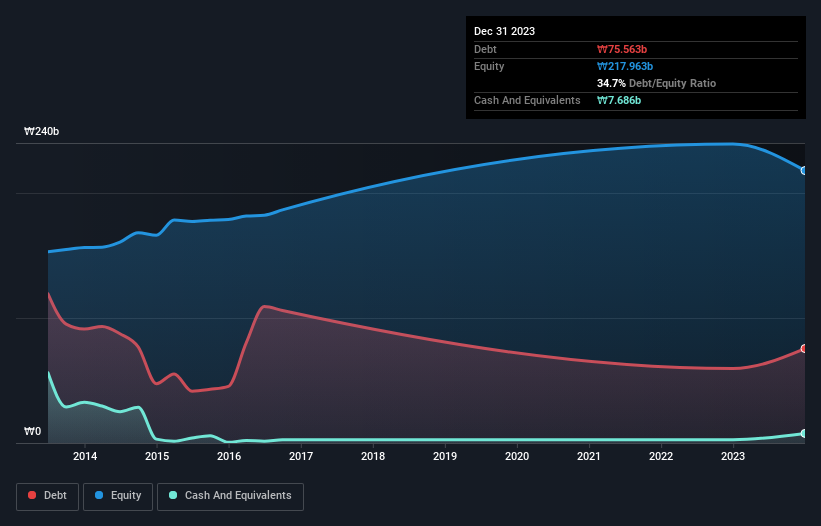
The external fund manager backed by Berkshire Hathaway's Charlie Munger, Li Lu, makes no bones about it when he says 'The biggest investment risk is not the volatility of prices, but whether you will suffer a permanent loss of capital.' When we think about how risky a company is, we always like to look at its use of debt, since debt overload can lead to ruin. Importantly, SAJO SEAFOOD Co.,Ltd (KRX:014710) does carry debt. But the more important question is: how much risk is that debt creating?
When Is Debt Dangerous?
Debt and other liabilities become risky for a business when it cannot easily fulfill those obligations, either with free cash flow or by raising capital at an attractive price. If things get really bad, the lenders can take control of the business. However, a more usual (but still expensive) situation is where a company must dilute shareholders at a cheap share price simply to get debt under control. Of course, debt can be an important tool in businesses, particularly capital heavy businesses. When we think about a company's use of debt, we first look at cash and debt together.
See our latest analysis for SAJO SEAFOODLtd
What Is SAJO SEAFOODLtd's Net Debt?
As you can see below, at the end of December 2023, SAJO SEAFOODLtd had ₩75.6b of debt, up from ₩59.6b a year ago. Click the image for more detail. However, because it has a cash reserve of ₩7.69b, its net debt is less, at about ₩67.9b.

A Look At SAJO SEAFOODLtd's Liabilities
According to the last reported balance sheet, SAJO SEAFOODLtd had liabilities of ₩93.5b due within 12 months, and liabilities of ₩8.63b due beyond 12 months. Offsetting this, it had ₩7.69b in cash and ₩19.8b in receivables that were due within 12 months. So its liabilities total ₩74.7b more than the combination of its cash and short-term receivables.
This deficit is considerable relative to its market capitalization of ₩78.0b, so it does suggest shareholders should keep an eye on SAJO SEAFOODLtd's use of debt. This suggests shareholders would be heavily diluted if the company needed to shore up its balance sheet in a hurry. There's no doubt that we learn most about debt from the balance sheet. But you can't view debt in total isolation; since SAJO SEAFOODLtd will need earnings to service that debt. So when considering debt, it's definitely worth looking at the earnings trend. Click here for an interactive snapshot.
In the last year SAJO SEAFOODLtd had a loss before interest and tax, and actually shrunk its revenue by 12%, to ₩176b. That's not what we would hope to see.
Caveat Emptor
While SAJO SEAFOODLtd's falling revenue is about as heartwarming as a wet blanket, arguably its earnings before interest and tax (EBIT) loss is even less appealing. Indeed, it lost a very considerable ₩35b at the EBIT level. When we look at that and recall the liabilities on its balance sheet, relative to cash, it seems unwise to us for the company to have any debt. Quite frankly we think the balance sheet is far from match-fit, although it could be improved with time. However, it doesn't help that it burned through ₩9.9b of cash over the last year. So in short it's a really risky stock. The balance sheet is clearly the area to focus on when you are analysing debt. However, not all investment risk resides within the balance sheet - far from it. For instance, we've identified 2 warning signs for SAJO SEAFOODLtd (1 is concerning) you should be aware of.
Of course, if you're the type of investor who prefers buying stocks without the burden of debt, then don't hesitate to discover our exclusive list of net cash growth stocks, today.
New: Manage All Your Stock Portfolios in One Place
We've created the ultimate portfolio companion for stock investors, and it's free.
• Connect an unlimited number of Portfolios and see your total in one currency
• Be alerted to new Warning Signs or Risks via email or mobile
• Track the Fair Value of your stocks
Have feedback on this article? Concerned about the content? Get in touch with us directly. Alternatively, email editorial-team (at) simplywallst.com.
This article by Simply Wall St is general in nature. We provide commentary based on historical data and analyst forecasts only using an unbiased methodology and our articles are not intended to be financial advice. It does not constitute a recommendation to buy or sell any stock, and does not take account of your objectives, or your financial situation. We aim to bring you long-term focused analysis driven by fundamental data. Note that our analysis may not factor in the latest price-sensitive company announcements or qualitative material. Simply Wall St has no position in any stocks mentioned.
About KOSE:A014710
SAJO SEAFOODLtd
Engages in the food, deep sea fishing, and frozen food storage businesses in South Korea.
Excellent balance sheet and good value.
Market Insights
Community Narratives



